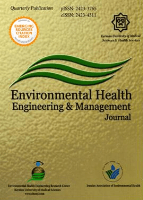
Environmental Health Engineering and Management Journal
Scope & Guideline
Pioneering Research for a Sustainable Future
Introduction
Aims and Scopes
- Environmental Health Risk Assessment:
The journal places a strong emphasis on assessing health risks associated with environmental exposures, including pollutants and hazardous materials. This involves epidemiological studies, risk modeling, and health surveillance. - Pollution and Contamination Studies:
Research on the sources, types, and effects of pollutants, including heavy metals, microplastics, and organic contaminants in various media (air, water, soil) is a core focus. This includes studies on the ecological impact and human health implications of such contaminants. - Innovative Waste Management Solutions:
The journal promotes research on innovative methods for waste management and treatment, including anaerobic digestion, electrocoagulation, and bioremediation techniques aimed at reducing environmental impact and enhancing sustainability. - Climate Change and Environmental Health:
Publications often explore the effects of climate change on health and environmental quality, including studies on air quality, heat stress, and water security, highlighting the need for adaptive management strategies. - Sustainable Practices and Technologies:
The journal supports research into sustainable technologies and practices that mitigate environmental hazards, including renewable energy, bioengineering, and the use of indigenous resources in environmental management.
Trending and Emerging
- Health Impacts of Emerging Contaminants:
There is an increasing focus on the health effects of emerging contaminants, such as microplastics and pharmaceuticals, in various environments. This trend signifies a growing recognition of the need for research on novel pollutants that were previously under-studied. - COVID-19 and Environmental Health Intersections:
Research linking the COVID-19 pandemic to environmental health issues, such as air quality and waste management, has surged. This reflects a broader understanding of how public health crises can influence and be influenced by environmental factors. - Spatial Analysis and Geographic Information Systems (GIS):
The use of spatial analysis and GIS in studying environmental health has gained traction. This approach allows for better assessment of exposure risks and health outcomes based on geographical data, enhancing the precision of environmental health studies. - Sustainable and Green Technologies:
A noticeable increase in research on sustainable technologies, including renewable energy solutions and eco-friendly waste treatment methods, indicates a shift towards sustainability in environmental health engineering. - Socioeconomic Factors in Environmental Health:
Emerging themes emphasize the interplay between socioeconomic factors and environmental health outcomes, highlighting how income inequality and social determinants impact exposure and health risks.
Declining or Waning
- Traditional Pollution Control Methods:
Research focusing solely on conventional pollution control methods has seen a decrease. The trend has shifted towards integrating advanced technologies and sustainable practices rather than relying on traditional approaches. - Generalized Environmental Impact Studies:
Broad, non-specific studies assessing environmental impacts without a clear focus on health outcomes are becoming less common. There is a growing preference for targeted research that directly links environmental issues to specific health risks. - Historical Environmental Health Issues:
Studies centered around historical contamination events or legacy pollutants are less frequently published. Current research tends to focus on contemporary and emerging pollutants, reflecting the need to address immediate health risks.
Similar Journals
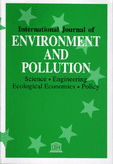
INTERNATIONAL JOURNAL OF ENVIRONMENT AND POLLUTION
Exploring the Complexities of Pollution and Ecosystem HealthInternational Journal of Environment and Pollution is a pivotal publication in the field of environmental science, dedicated to advancing knowledge concerning pollution and its multifaceted impacts on ecosystems and human health. Published by InderScience Enterprises Ltd, this journal, which has been in circulation since 1991, serves as a vital platform for researchers, professionals, and students interested in the management, monitoring, policy, and law associated with environmental issues. With an ISSN of 0957-4352 and E-ISSN 1741-5101, it offers a critical perspective on pollution challenges, emphasizing Waste Management and Disposal. Although placed in the Q4 quartile of its categories, it remains an important resource for understanding the complexities of environmental impact, contributing to policy formulation and ecological research. The journal does not offer Open Access, but it can be accessed through various academic libraries and institutions that value comprehensive studies in environmental management. Engage with the latest findings and discussions that address pressing environmental concerns today!

Journal of Environmental Health Science and Engineering
Advancing the frontiers of environmental health and engineering.Journal of Environmental Health Science and Engineering, published by Springer, stands at the forefront of scholarly research in environmental health and engineering. With an impressive E-ISSN of 2052-336X and a significant impact factor reflected in its Q2 quartile rankings across various essential categories—including Applied Microbiology, Environmental Engineering, and Public Health—the journal serves as a vital platform for disseminating high-quality research from 2012 to 2024. Its rankings in fields such as Environmental Science and Waste Management position it as a distinguished resource for professionals and academics aiming to advance their understanding of contemporary environmental challenges. As an open-access journal based in Switzerland, it champions accessibility and collaboration, allowing researchers to share insights that influence policy and practical applications in environmental health. The journal's commitment to fostering innovative research makes it indispensable for those dedicated to enhancing the intersection of environmental science and public health.
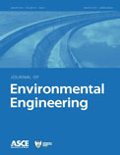
JOURNAL OF ENVIRONMENTAL ENGINEERING
Transforming knowledge into action for a greener tomorrow.JOURNAL OF ENVIRONMENTAL ENGINEERING, published by the American Society of Civil Engineers (ASCE), stands as a pivotal platform within the realm of environmental engineering and civil infrastructure. With an ISSN of 0733-9372 and an E-ISSN of 1943-7870, this esteemed journal has been delivering high-quality research since its inception in 1973 and continues to play a crucial role in advancing knowledge through to 2024. The journal boasts respectable impact factors, achieving Q2 rankings in Civil and Structural Engineering, Environmental Engineering, and Environmental Science, while also maintaining a solid presence in Environmental Chemistry. With Scopus rankings reflecting a strong competitive advantage across various specializations, it serves as a vital resource for researchers, professionals, and students focused on solving complex environmental challenges. Though not an open-access publication, its rigorous selection process ensures that only high-caliber studies are disseminated, making it an indispensable read for anyone involved in the interdisciplinary fields linking engineering and environmental sustainability. Addressing contemporary issues and shaping future innovations, the JOURNAL OF ENVIRONMENTAL ENGINEERING remains committed to fostering dialogue and disseminating impactful research.
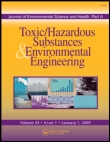
JOURNAL OF ENVIRONMENTAL SCIENCE AND HEALTH PART A-TOXIC/HAZARDOUS SUBSTANCES & ENVIRONMENTAL ENGINEERING
Shedding light on toxic threats to our ecosystem and health.JOURNAL OF ENVIRONMENTAL SCIENCE AND HEALTH PART A-TOXIC/HAZARDOUS SUBSTANCES & ENVIRONMENTAL ENGINEERING, published by TAYLOR & FRANCIS INC, stands at the forefront of research in the dynamic fields of environmental science and public health. With an ISSN of 1093-4529 and an E-ISSN of 1532-4117, this journal serves as a pivotal platform for disseminating significant findings regarding toxic substances and their impact on the environment and human health. It is categorized in the Q3 quartile for both Environmental Engineering and Medicine in 2023, showcasing its relevance within these disciplines. Researchers will find valuable insights in the 90th rank among 197 in the Environmental Science and Engineering category, placing it in the 54th percentile among its peers. While access options remain traditional rather than open-access, the journal is dedicated to serving as an essential resource for professionals and academics engaged in understanding the intricate connections between hazardous materials and environmental safety. The journal has consistently published critical research since its inception in 1978 and is committed to advancing knowledge up to 2024, making it a crucial venue for ongoing discussions and developments in environmental health.

ENVIRONMENTAL SCIENCE AND POLLUTION RESEARCH
Pioneering Research in Environmental ScienceEnvironmental Science and Pollution Research is a premier international journal published by Springer Heidelberg, dedicated to advancing knowledge in the field of environmental science and pollution. With an impressive impact factor reflecting its vital contributions to research, the journal is categorized in the top quartiles (Q1 and Q2) across several domains, including Health, Toxicology and Mutagenesis, and Environmental Chemistry. Established in 1994, it continues to be a critical resource for researchers, professionals, and students focusing on pressing environmental issues. The journal provides an insightful platform for disseminating significant findings related to pollution and its effects on health and the environment, contributing to a better understanding and resolution of these challenges. While it currently does not offer Open Access options, its inclusion in prominent rankings, such as the Scopus rankings, underscores its reputation and influence within the scientific community.

Pollution
Connecting researchers to tackle pressing environmental issues.Pollution is a distinguished open-access journal published by UNIV TEHRAN, dedicated to advancing the understanding of environmental science and the multifaceted aspects of pollution research. Since its establishment in 2015, the journal has been committed to disseminating high-quality, peer-reviewed articles that address the pressing issues of environmental degradation globally. With an impact factor and a Scopus rank that places it within the top tier of Environmental Science (Rank #141/233), Pollution serves as an essential resource for researchers, professionals, and students alike. The journal encompasses a wide range of topics, including the sources, effects, and mitigation strategies related to various forms of pollution, thereby aiming to contribute significantly to the scientific community's efforts in promoting environmental sustainability. Its innovative and timely approach positions Pollution as a vital platform for sharing knowledge and fostering interdisciplinary collaboration in the environmental science domain.

Rocznik Ochrona Srodowiska
Championing Environmental Protection through Scholarly ContributionsRocznik Ochrona Srodowiska, published by the Middle Pomeranian Scientific Society for Environmental Protection, is an esteemed journal dedicated to advancing the field of environmental science in Poland and beyond. With an ISSN of 1506-218X, this peer-reviewed journal has established itself as a vital resource since its inception in 2007, addressing various environmental issues and promoting sustainable practices. Currently holding a Q3 category ranking in the Environmental Science (miscellaneous) field for 2023, it places itself in the 23rd percentile of Scopus rankings, reflecting a growing influence in the broader environmental research community. While the journal is not open access, it serves as an important conduit for researchers, professionals, and students to disseminate their findings and contribute to the interdisciplinary dialogue aimed at tackling pressing environmental challenges. With a commitment to rigorous research and practical applications, Rocznik Ochrona Srodowiska remains an essential platform for fostering innovation and collaboration in environmental studies.

WATER AIR AND SOIL POLLUTION
Uniting science and technology to tackle environmental challenges.Water Air and Soil Pollution is a leading peer-reviewed journal published by Springer International Publishing AG, focusing on the vital fields of environmental sciences, ecological modeling, and pollution management. Since its inception in 1971, the journal has contributed significantly to advancing knowledge in the interdisciplinary realms of Water Science and Technology, Environmental Chemistry, and Environmental Engineering. With an impressive history, the journal currently holds a Q2 quartile ranking in several categories, reflecting its high impact and relevance in these essential areas of research. Its rankings—such as #95 in Environmental Science: Water Science and Technology—illustrate its standing in the academic community. Researchers and practitioners alike can access a wealth of studies and reviews that aim to address pressing environmental concerns and foster sustainable practices, although the journal is not Open Access. Located in Switzerland, Water Air and Soil Pollution continues to be a critical resource for those dedicated to understanding and mitigating pollution, making it an indispensable tool for anyone engaged in ecological and environmental research.
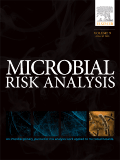
Microbial Risk Analysis
Empowering Research in Infectious Disease DynamicsMicrobial Risk Analysis, published by Elsevier, is a pivotal academic journal specializing in the intersection of epidemiology, infectious diseases, and medical microbiology. With an ISSN of 2352-3522 and an E-ISSN of 2352-3530, this journal has been contributing to the field since its inception in 2016 and continues to invite groundbreaking research as it converges through 2024. With a respectable impact factor, Microbial Risk Analysis holds a Q3 designation in key categories, showcasing its credibility with ranks such as #48 in Epidemiology and #124 in Infectious Diseases according to Scopus. The journal serves as an essential platform for researchers, professionals, and students alike, aiming to enhance understanding of microbial risks and their public health implications. Although it operates under a subscription model, its contents remain accessible to a broad range of interdisciplinary scholars dedicated to advancing microbial research. For those at the forefront of epidemiological and infectious disease studies, Microbial Risk Analysis represents a crucial resource for disseminating knowledge and fostering collaboration.
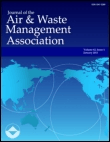
JOURNAL OF THE AIR & WASTE MANAGEMENT ASSOCIATION
Bridging Theory and Practice in Air and Waste ManagementJOURNAL OF THE AIR & WASTE MANAGEMENT ASSOCIATION is a leading publication in the fields of environmental science, pollution control, and waste management, published by Taylor & Francis Inc in the United Kingdom. With an impressive history of publication dating back to 1989 and a commitment to advancing knowledge and practice in these critical areas, this journal serves as a valuable resource for researchers, professionals, and students alike. It holds a 2023 impact factor reflected through its competitive rankings in four distinct categories: Q3 in Atmospheric Science and Q2 in Management, Monitoring, Policy and Law, Pollution, and Waste Management and Disposal. The journal's dedication to disseminating innovative research and best practices plays a vital role in enhancing environmental policies and strategies globally. Although not currently Open Access, the journal is accessible through its ISSN 1096-2247 and E-ISSN 2162-2906, providing opportunities for rich academic discussion and collaboration in addressing pressing environmental challenges.